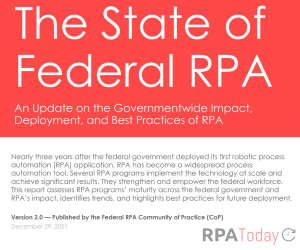
Just over a year ago, the U.S. General Services Administration’s RPA Community of Practice (CoP) published its first ever report on The State of Federal RPA. On Dec. 29, 2021, the CoP updated the report, which provides a comprehensive look at how RPA initiatives in the federal government are progressing, what agencies are engaged in successful RPA efforts and which projects are scaling.
In addition to presenting a baseline set of metrics that will enable the government to measure the effectiveness and growth of its automation deployments every year, the report also offers a framework for measuring the “maturity” of RPA efforts, creating a way to calculate ROI, how agencies can accelerate RPA programs and the challenges that might prevent future adoption and growth of RPA across the federal government. Private companies can use the framework to assess their programs.
“RPA technology continues to improve processes,” said Gerard Badorrek, CFO of GSA and federal RPA CoP sponsor. “This year, RPA programs across the government increased their number of automations in production to around one thousand. They created over a million hours of capacity.”
The 2021 study assessed eight characteristics that show RPA maturity across 65 government agencies: automations in production, annualized hours of workload reduction, process improvement capabilities, program impact, opportunity identification, production environment, security and technology approach, and intelligent automation capabilities. In the newly updated version of the report, community development, audit readiness and dashboard availability were added to the inputs to generate maturity scores.
Key findings include:
· RPA programs have eliminated 1.4 million hours of low-value work to date across the federal government
· 65 percent of RPA programs have more than 20 automations in their pipelines
· One-third of RPA programs have incorporated intelligent automation capabilities (e.g., machine learning, image recognition, natural language processing)
· Nearly 70 percent of federal RPA programs are centralized with program management


